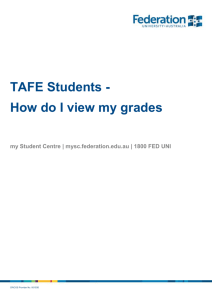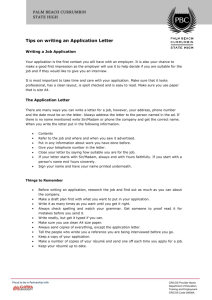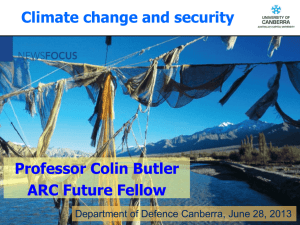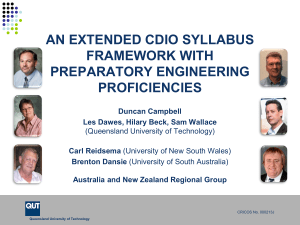Brian Fitzgerald, Queensland University of Technology
advertisement
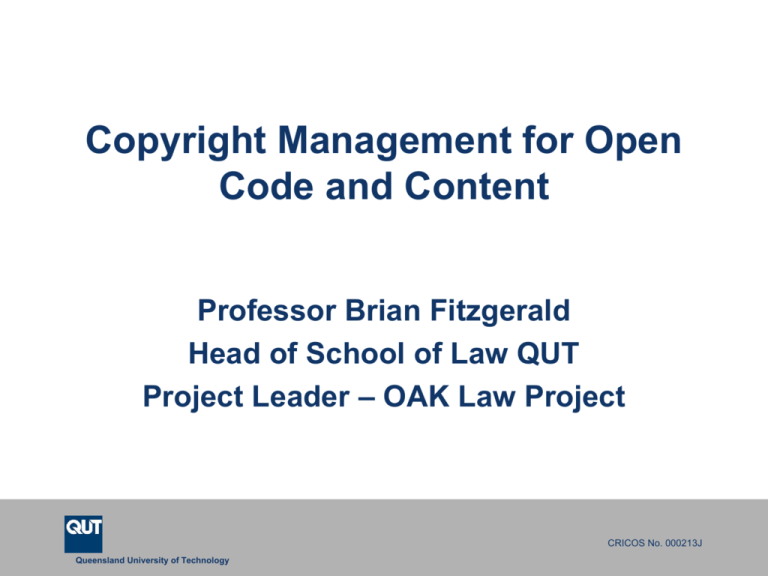
Copyright Management for Open Code and Content Professor Brian Fitzgerald Head of School of Law QUT Project Leader – OAK Law Project CRICOS No. 000213J Queensland University of Technology Free and Open Source Software (FOSS) CRICOS No. 000213J Queensland University of Technology Back to Basics I What is IP Law? • A key issue here is IP - copyright or patent on software code • Why have IP - 4 theories - utility, labour, personhood, culture • IP in form of copyright has covered code since early 1980s and patents more so since early 1990s • International IP Treaties - multilateral - Berne, TRIPs bilateral - AUSFTA • Jurisdiction a university for the real world R CRICOS No. 000213J Back to Basics II What is Copyright Law? • • • • • • • Subject matter Ownership Exclusive Rights – Economic and Moral Exceptions – Fair Dealing Licences – Voluntary and Statutory Assignment Infringement – substantial part, no permission a university for the real world R CRICOS No. 000213J Back to Basics III Ownership • Copyright - author the owner of CR - exception is code created in the course of employment - employee; contractor will own the code unless assigned • Government Copyright see ss 176, 177, 179 Copyright Act government would normally have IP in code it is developing contract should contain the detail • Exclusive rights of CR owner in US - include right to create a derivative work s 106 US Copyright Act - so downstream developer needs permission to create a derivative (defined in s 103 US Copyright Act) - unlawful to do otherwise - no copyright will arise GNU GPL built on this right – Australia – s 31 Copyright Act reproduction/communication/adaptation – permission a university for the real world R CRICOS No. 000213J Understand the Landscape I Code Distribution • Fundamentally we are talking about the way code (in itself a form of knowledge) is distributed • Proprietary (Closed) – machine readable • Free “as in speech not as in beer” (Open) - source code available • Impact for developers – a community of effort leading to rapid and untold innovation • Impact for users – being able to see/study immediately the good and bad points of the code a university for the real world R CRICOS No. 000213J Closed Source Code Model • …a competitor who is free to review Microsoft’s source code…will see the architecture, data structures, algorithms and other key aspects of the relevant Microsoft product. That will make it much easier to copy Microsoft’s innovations, which is why commercial software vendors generally do not provide source code to rivals: State of New York v Microsoft Corporation, Direct Testimony of Bill Gates, April 18 2002 [http://www.microsoft.com/presspass/trial/mswitness/200 2/billgates/billgates.asp], para [307] April 20 2002 a university for the real world R CRICOS No. 000213J Community Based • …release early and often, delegate everything you can, be open to the point of promiscuity…No quiet, reverent cathedral-building here -- rather, the Linux community seemed to resemble a great babbling bazaar of differing agendas and approaches (aptly symbolized by the Linux archive sites, who'd take submissions from anyone) out of which a coherent and stable system could seemingly emerge only by a succession of miracles. • Eric Raymond, The Cathedral and the Bazaar, version 2, 24 August 2000, <http://www.tuxedo.org/~esr/writings/cathedralbazaar/cathedral-bazaar/index.html>, (27 July 2001) a university for the real world R CRICOS No. 000213J Raymond’s Essentials • Good programmers know what to write. Great ones know what to rewrite and reuse. • Many programmers build on the efforts of others rather than doing things from scratch. • The best programs are written by reacting to a need perceived by programmers. • Treating users as co-developers allows bugs to be identified quickly and more effectively. • Scalability of reaction to a perceived problem that commercial developers have come to realize. “[G]iven enough eyeballs, all bugs are shallow“ • Programs are best released early and often and feedback sought from users. a university for the real world R CRICOS No. 000213J FSF – four freedoms • The freedom to run the program, for any purpose. • The freedom to study how the program works, and adapt it to your needs. • The freedom to redistribute copies so you can help your neighbour. • The freedom to improve the program, and release your improvements to the public, so that the whole community benefits. Free Software Foundation, The Free Software Definition, http://www.fsf.org/philosophy/free-sw.html a university for the real world R CRICOS No. 000213J Understand the Landscape II Free Software : The Concept • Free Software is a philosophy, a culture, a social system and an economy all in one • It survives and prospers on grass roots support of a global team of developers who rely on its openness • It is supported by a brilliant yet rudimentary legal structure that has never been subject to substantial judicial interpretation • It’s regulatory structure (advisory and enforcement) is implemented by leading figures within FSF like Stallman and Moglen a university for the real world R CRICOS No. 000213J Understand the Landscape III Terminology and Ideology • Free Software is epitomised by the GNU GPL – the obligation to share code if you distribute a work based on GPL’d code – derivative work – but code released under the BSD is also free software • Open Source is different? Eric Raymond, Cathedral and the Bazaar • Fundamental difference - pp 120-121 - “OS is a development method - FS is a philosophy” a university for the real world R CRICOS No. 000213J (B1) Benefits of Free Software for Govt • Cost – the provider of a “fully redistributable system containing only free software can reduce the unit cost of software to zero” (Eben Moglen) • Interoperability • Security – Easier to identify and fix problems • Agency and International Collaboration • Promotes Open Standards – (Knowing What is Needed – Process, Protocol, Format) – Future proofing data – Avoiding vendor lock-in a university for the real world R CRICOS No. 000213J (B2) Benefits – Community Benefits • Providing value to the community – Returning the benefit of public funded software innovations to the public – Providing guidance and resources for technological innovations – Code as law – the law should be transparent – FS as Democratic Principle • Code Orphaning – Preventing lost value in locked up, discarded or unused code • Code databases – Potential to make Australian development more efficient by providing access to greater code resources a university for the real world R CRICOS No. 000213J (PP1) Procurement Policy - Government “Buying In” FOSS • Commonwealth Financial Management and Accountability Act 1997 • Commonwealth Procurement Guidelines (CPG) - “value for money” “fit for purpose” • Level Playing field for FOSS – to be reinforced by best practice rather than legislation? • AGIMO, OSS Position Paper 31 August 2004 http://www.agimo.gov.au/infrastructure/oss • The Government will continue to encourage the use of open source software solutions by developing a range of tools to help Government agencies make informed decisions to suit their IT needs and get value for money, Minister for Communications, Information Technology and the Arts, Senator Helen Coonan, announced today. • AGIMO, A Guide to Open Source Software for Australian Government Agencies (2005) a university for the real world R CRICOS No. 000213J (PP2) Government Procurement (Principles) Guideline Amendment Act 2003 (ACT) • Requires ACT entities to consider open source software and avoid (s 6A(1)(b)): – “software that does not comply with open standards”; and – software “for which support or maintenance is provided only by an entity that has the right to exercise exclusive control over its sale or distribution”. • ‘Open Standards’ is defined as where “the specifications […] are completely and accurately documented and available to the public for use, application or review without restriction” (s 6A(3)). • ‘Open Source’ means definition by OSI (s 6A(4)). • Act expires three years from enactment (s 6A(5)). a university for the real world R CRICOS No. 000213J (PP3) Indemnities and warranties for title, performance and loss • FOSS – “As is Basis” – Response? • Risk analysis – should a large vendor be contracted to supply software? – Indemnities against claims of intellectual property infringement and other loss – Warranties that the software provided works and will continue to work – GITC framework • Should a level of risk be assumed? Is it inevitable? What level of in house support and expertise is involved? • To what extent can fitness for purpose and loss be excluded under law - Trade Practices Act 1974 a university for the real world R CRICOS No. 000213J (D1) Government as Developer • Sections 176-179 Copyright Act 1968 – Crown Copyright – CLRC Crown Copyright Report • Understand the various FOSS licences – GNU GPL (copyleft – share code of derivative work on distribution), BSD (non copyleft – CR notice) a university for the real world R CRICOS No. 000213J (D2) GNU GPL 1. You may copy and distribute verbatim copies of the Program's source code as you receive it, in any medium, provided that you conspicuously and appropriately publish on each copy an appropriate copyright notice and disclaimer of warranty; keep intact all the notices that refer to this License and to the absence of any warranty; and give any other recipients of the Program a copy of this License along with the Program. 2. You may modify your copy or copies of the Program or any portion of it, thus forming a work based on the Program, and copy and distribute such modifications or work under the terms of Section 1 above, provided that you also meet all of these conditions: [...] You must cause any work that you distribute or publish, that in whole or in part contains or is derived from the Program or any part thereof, to be licensed as a whole at no charge to all third parties under the terms of this License. [...] a) b) c) GNU GPL, http://www.gnu.org/copyleft/gpl.html a university for the real world R CRICOS No. 000213J (D3) The obligation to redistribute modifications • Under the GPL, a person is obliged to distribute source code of any derivative works they make and distribute (GPL cl 2(b)). • Derivative work – two interpretations: – Strict: any use of GPL code creates a derivative work – Purposive: a derivative work is created if the original source was used or modified – the obligation is generated by more than touching a university for the real world R CRICOS No. 000213J (D4) The obligation to share modifications - Distribution • “Federal Government agencies may share free software without making a ‘distribution’” – Moglen. • Same would hold for intra-state sharing • Federal State? – One indissoluble Federal Commonwealth under the Crown • Department Statutory Corporations? – Probably a distribution a university for the real world R CRICOS No. 000213J (D5) The obligation to share modifications • The obligation will never attach to information processed or stored by open source applications. • Sensitive information embedded in code can be protected by: – Keeping sensitive or confidential info in separate modules, not released under the GPL; or – Avoiding distribution to non-government entities or statutory corporations. a university for the real world R CRICOS No. 000213J Enforceability of GNU GPL • Against infringing users – Licence is granted to copy the original code on the condition that certain procedures are followed – Failure to follow procedures means that the user has no right to copy the original code – One court decision in Germany – Acceptance – cl 5 • Against copyright owner – Gratuitous licences can be revoked at will. (GPL - Contract or licence) – Equitable estoppel may be available to prevent revocation of GNU GPL – Community based solutions a university for the real world R CRICOS No. 000213J Other Issues • GPL Compatibility – joining GPL’d and other code – more restrictive = problems, less restrictive BSD = no problems – can you licence whole under GPL • Dual Licensing – copyright owner • Patents – cl 7, • SCO v IBM • University researchers and FOSS – what if the University claims the IP • Porting? • GPL Version 3 TPM’s, patents etc. a university for the real world R CRICOS No. 000213J Further Reading • B Fitzgerald and G Bassett (eds) Legal Issues Relating to Free and Open Source Software (2003), available at: http://www.law.qut.edu.au/about/staff/lsstaff/fitzgerald.jsp • Open Source in Govt - Global Chart - CSIS http://www.csis.org/tech/OpenSource/index.htm • Glen Moody, Rebel Code: Linux and the Open Source Revolution, Penguin Books, 2001 • Sam Williams, Free as in Freedom: Richard Stallman’s Crusade for Free Software, O’Reilly, 2002 • B Fitzgerald and Nic Suzor, “Legal Issues For the Use of Free and Open Source Software in Government” (2005) 29 Melbourne University Law Review 412 a university for the real world R CRICOS No. 000213J Open Content Licensing as An IP Management Strategy CRICOS No. 000213J Queensland University of Technology CC: Key Themes • Sharing, Accessing, Collaborating and Negotiating: Content, Knowledge, Culture and Production – “with a minimum of fuss” • Fueled by the negotiability, innovation and creative potential of the digital environment – “cut and paste”, “remix” “P2P” • Free Culture – Free to Access – a repository of open space or commons unencumbered by large transaction costs and threats of law suits - Lessig, The Future of Ideas (2001); Free Culture (2004) • Creative Innovation – core economic driver – Florida, Rise of the Creative Class (2002) – CC slogan “get creative” • Peer to Peer Production and User Led Innovation - Y Benkler, “Coase's Penguin, or Linux and the Nature of the Firm”, (2002) 112 Yale Law Journal 369 – Collaborative Innovation a university for the real world R CRICOS No. 000213J Implementing CC • Locate/build and inform people of creative resources • Establish easy to implement generic non discriminatory protocols for access to and reutilising or reusing of content – a process of “licensing out” • Make it easier to negotiate out or access copyright material • Builds on free software model a university for the real world R CRICOS No. 000213J Four main protocols • Attribution: Other people may use, modify and distribute the work, as long as they give the original author credit. • Non-commercial: Other people may use, modify and distribute the work, but for non-commercial purposes only. • No derivatives: Other people may use and distribute the work, but can not modify it to create derivative works. • Share alike: Other people may modify the work and distribute derivatives, but only on the condition that the derivatives are made available to other people on the same licence terms. This term can not be used with the No Derivatives term, because it applies only to derivative works. • Need to mention Moral Rights (asserted) in Australian licence a university for the real world R CRICOS No. 000213J International Creative Commons iCommons • Christiane Asschenfeldt – iCommons Coordinator • QUT – Institutional Affiliate in Australia Translating licences and philosophy of creative commons into each national jurisdiction – porting – to assist enforceability Differences Australian to US law: copyright terminology, TPA, moral rights a university for the real world R CRICOS No. 000213J a university for the real world R CRICOS No. 000213J a university for the real world R CRICOS No. 000213J a university for the real world R CRICOS No. 000213J CC Badge a university for the real world R CRICOS No. 000213J a university for the real world R CRICOS No. 000213J a university for the real world R CRICOS No. 000213J Existing Projects • Public Library of Science – www.plos.org – uses CC • AEShareNet – AESL a corporation funded in part by Commonwealth and State Governments • Australian Creative Resource Archive (ACRA) – UQ Ipswich www.acro.edu.au • BBC Creative Archive http://creativearchive.bbc.co.uk/ • Creative Commons Search Engine – search.creativecommons.org • CommonContent.org Website • Over 53 million objects – linked to CC licenses • Australian users: LAMS Community www.lamscommunity.org OnlineOpinion.com.au Vibewire.net.au Creativecommons.org.au a university for the real world R CRICOS No. 000213J a university for the real world R CRICOS No. 000213J a university for the real world R CRICOS No. 000213J Application to Government • • • • State/Government Ownership of Copyright CLRC Report – www.clrc.gov.au Open Content Licensing possibilities EU Directive on Reuse of and OECD Work on Public Sector Information (PSI) Management • UK Common Information Environment (CIE) – CC in the UK Public Sector – www.intrallect.com/ciestudy/Report%20for%20CIE%2019th%20July.pdf a university for the real world R CRICOS No. 000213J Relationship to Copyright • Not anti-copyright • Relies on and is complementary to copyright • Aims to make copyright more alive active and accessible a university for the real world R CRICOS No. 000213J Motivation for Sharing • • • • • • • Ideologically and financially this may be acceptable – the most compelling example in Australia is government where information is ultimately owned by and for the people Open contenting one version of your material e.g. a draft (E Print) or a chapter may in fact be a strategy for enhancing the commercialised version of your content A wish to share with others for creative and educational purposes – peer production Publicity – what the free and open software movement calls “egoboo” or reputation within the open community which in some cases will be exploited commercially down the track Negotiability – through technologically implemented generic protocols that can be utilised with the click of a mouse “What is junk to one may be gold to another” – the idea that the off cuts or digital junk of one person may be the building blocks of knowledge and creative genius for another “indirect appropriation” – money, design and use of end product, pleasure or social profile gained through involvement in peer production - Benkler a university for the real world R CRICOS No. 000213J The Dynamic of Distributed Knowledge • The dynamic of serendipitous creation, research and innovation – allowing unknown parts and paths to be joined together through the dynamic nature of a distributed web – CC facilitates the negotiation of IP rights in this environment • Collaboration the new innovation • Important to teachers and students • Libr@ries will need to understand these developments a university for the real world R CRICOS No. 000213J Open Access • The Open Access (OA) Movement is intimately connected with the Creative Commons movement and particularly the Science Commons project <sciencecommons.org>. Open Access as defined in the Berlin Declaration on Open Access to Knowledge in the Sciences and Humanities (2003) http://www.zim.mpg.de/openaccess-berlin/berlindeclaration.html and the Bethesda Statement on Open Access Publishing (2003) http://www.earlham.edu/~peters/fos/bethesda.htm seeks to open up access to research, data sets and scholarship especially that which is publicly funded. Creative Commons licences are seen as a mechanism through which open access to research can be promoted: R Poynder, “The Role of DRM in Open Access” (2005) www.indicare.org a university for the real world R CRICOS No. 000213J Teaching and Learning • • • • A recent high-level report from the Australian Carrick Institute for Learning and Teaching in Higher Education authored by Deborah Southwell et al entitled Strategies for effective dissemination of project outcomes (2005) the following comments are made: In recent months potential answers to some of these questions have developed in the form of a wider understanding about new forms of licensing which involve the sharing of rights rather than holding an exclusive monopoly of rights. Perhaps the best known of these forms internationally is the Creative Commons licence, of which an Australian version has been in existence since January 2005. Under Creative Commons licenses, it is possible for creators of intellectual property to provide conditions in which others may use copy and modify their work, providing that the results of this are fully attributed, and that the uses to which the intellectual property is put are not commercially exploited unless this is specifically agreed. Creative Commons licensing offers the possibility of accelerating the dissemination of innovation because it reduces confusion or uncertainty in terms of the disposition of IP that might be created, particularly in circumstances where the development of content is as a result of public investment of one form or another. The development of this form of licensing comes at a time when at a policy level the Commonwealth is also concerned to see that the results of publicly funded research are available in a more open and generally accessible way than they have been to date, particularly where research outputs are the subject of monopoly approaches to the assignment of copyright in publishing. A generally applicable guideline in the dissemination of teaching innovations should be that a Creative Commons licensing approach should be the de facto approach to assist dissemination. (pp24-25) a university for the real world R CRICOS No. 000213J DEST SII “Legal Protocols” Project • This Project starting immediately and running through to the middle of 2007 will consider management of copyright for open access in research repositories • QUT is the lead institution – I am project leader • Open Access to Knowledge (OAK) Law Project www.oaklaw.qut.edu.au • Other SII projects – APSR, ASK/OS, ARROW and DART, ADT ; Dictionaries a university for the real world R CRICOS No. 000213J QUT Led ARC Centre of Excellence in Creative Industries and Innovation • • • • Considers Creative Innovation Including Creative Workforce I am Project Leader of Law Creative Commons Clinic – across Law, Education, Business, IT and Creative Industries • Creative Commons Research • www.cci.edu.au a university for the real world R CRICOS No. 000213J Why CC is important? • Provides a facility for those that want to share copyright material lawfully - to augment knowledge • Sponsors and Profiles creativity • Allows collaboration and annotation - CCMixter • Links in with the growth of open access repositories providing new sources of knowledge • Open to all • Allows you to release a NC version under CC and still commercialise any other version • Core Skill of the digital generation a university for the real world R CRICOS No. 000213J OAK Law Project - Copyright • • • • PhDs Pre and Post Prints Compatibility of Licences, Non Commercial, Jurisdiction Liability and Rights of contributor, copyright owner, creator, repository, users, institutions/government, and third party – for deposit, access, management, storage and communication • REL - ODRL a university for the real world R CRICOS No. 000213J Electronic Theses & Dissertations repository student supervisor/third party a university for the real world funding agency/business R CRICOS No. 000213J ETD questions for OAK Law Project – – – – – – – – – How to manage licensing of distribution, and interests of the parties? How is the whole work to be regarded? Is it discipline dependant? How to manage cited materials? How to manage contributions by others? (eg technician photos, cite charts etc) How to manage derivative works? How to manage confidential information (pre-patent materials)? Liability and risk management? What protocols should be adopted? a university for the real world R CRICOS No. 000213J Pre and Post Prints author’s original idea author’s draft versions author’s final draft refereeing process ? assign copyright author retains copyright publisher acquires copyright licence terms (express/implied) determine scope of permitted uses, including extent of self-archiving a university for the real world licence to author or educational institution or third party eg repository R CRICOS No. 000213J Pre and Post Prints (1) Where author retains copyright may license article to publisher on a non-exclusive basis see eg Creative Commons Open Access Law: Publication Agreement & Copyright License at http://sciencecommons.org/literature/oalawpublication author grants to the Publisher a royalty-free, worldwide, non-exclusive license to publish, reproduce, display, distribute, and use the article in any form author retains control over other forms of distribution, including by a General Licence - author and publisher agree in clause 1 that author can grant CC licenses to the general public - The Publisher indicates which CC licenses the Publisher is willing to allow the Author to grant by checking and initialling the appropriate boxes in the "Publisher" column in the table - The Author must check one and only one box below and write Author's initials in the adjacent space to indicate which, if any, CC licence the author grants a university for the real world R CRICOS No. 000213J Pre and Post Prints Open Access Law: Publication Agreement & Copyright License a university for the real world R CRICOS No. 000213J Pre and Post Prints (2) Where copyright is assigned to publisher, on what conditions should Pre and Post Prints be distributed? international dialogue - Roger Clarke, Stevan Harnad and others informal v formal approach should it be left to what can be implied from industry practice/s or should it be expressed in a written licence? should authors simply self-archive or should they expressly grant licences to others, using open content licences eg CC Roger Clarke favours inclusion of express licence terms in Pre and Post Prints - proposes CC By-NCND (Attribution/Non Commercial/No Derivative Rights) as suitable for: Pre Prints (where it is anticipated copyright will be assigned to publisher) AND Post Prints - where copyright is assigned to publisher and publisher grants a licence back to author to: 1. continue to make Pre Print available and to make Post Print available ("green"), or 2. continue to make Pre Print available but not permitted to publish Post Print ("yellow"), or 3. make Post Print available but Pre Print to be withdrawn from circulation ("blue"). See Clarke - "A Proposal for an open content licence for research paper (Pr)ePrints" (2005), http://firstmonday.org/issues/issue10_8/clarke/index.html and "A Standard Copyright Licence for PostPrints" (2005), http://www.anu.edu.au/people/Roger.Clarke/EC/PostPrLic.html a university for the real world R CRICOS No. 000213J OAK Law Project Contacts Professor Brian Fitzgerald (Project Leader) bf.fitzgerald@qut.edu.au Skype: oakleader Scott Kiel-Chisholm (Project Manager) s.kielchisholm@qut.edu.au Skype: oaklawproject Dr Renato Iannella – renato@nicta.com.au Professor Mark Perry – m.perry@qut.edu.au Professor Anne Fitzgerald – am.fitzgerald@qut.edu.au General Enquiries Phone: 07 3864 1634 Email: oaklaw@qut.edu.au Website: www.oaklaw.qut.edu.au Skype: oaklaw2 a university for the real world R CRICOS No. 000213J
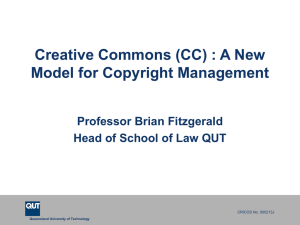
![e-Exemption, Application for []](http://s3.studylib.net/store/data/008785386_1-026ce651779c9693dde4b1ba9583a68c-300x300.png)
